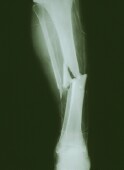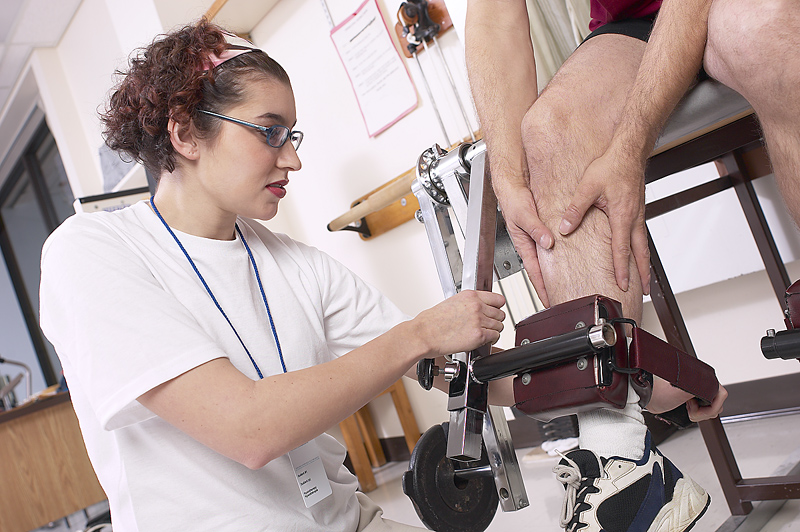
WEDNESDAY, May 8 (HealthDay News) — Mutations in a gene involved in bone development appear to cause certain severe forms of bone loss, a finding that could lead to new therapies for the common bone-thinning disorder osteoporosis, researchers report.
The mutations were found in a Swedish family with 10 members affected by a severe, early onset form of osteoporosis, as well as a Hmong family from Laos in which two sisters suffered from osteogenesis imperfecta.
Osteogenesis imperfecta, which is also known as brittle bone disease, affects six to seven out of every 100,000 people worldwide. The disease causes the bones to break easily, often from little or no trauma. There are four main forms, the most severe of which is fatal before or soon after birth.
The most common — and mildest — form is Type 1, in which most of a child’s bone fractures happen before puberty. Some other problems, such as weak muscles and brittle teeth, are also possible.
Researchers have long known that about 90 percent of osteogenesis imperfecta cases are caused by a single mutation in one of two genes involved in making collagen, a fibrous protein in bone, skin and connective tissue.
It is only in the past decade, though, that the mystery behind the other 10 percent has become clearer, said Dr. Francis Glorieux, chairman of the Osteogenesis Imperfecta Foundation’s medical advisory council.
The latest findings, published in the May 9 issue of the New England Journal of Medicine, underscore the role of a gene family known as WNT, said Glorieux, who was not involved in the research.
WNT genes make proteins called ligands, which means they latch onto receptors on the surface of body cells. Scientists have known that WNT is important in bone development and the upkeep of bone mass.
“But we haven’t known which protein is key, which WNT ligand is actually doing the work. This study addresses that,” said lead researcher Dr. Brendan Lee, a professor of molecular and human genetics at Baylor College of Medicine in Houston.
Specifically, Lee’s team found two mutations in the WNT1 gene — one that caused early onset osteoporosis in the Swedish family, and one that caused a more severe form of osteogenesis imperfecta in the Asian family.
The study is one of four in the past two months alone that have identified various WNT1 mutations in families affected by osteogenesis imperfecta. “It’s a hot topic right now,” said Glorieux, who worked on one of those studies.
Together, the studies “underscore the importance of this protein in controlling bone formation,” Lee said.
Both Lee and Glorieux said studying severe forms of brittle bone disease also gives insight into the common form of osteoporosis that affects many older adults.
In the United States, about 16 percent of women older than 50 have full-blown osteoporosis of the hip or lower spine, as do 4 percent of men, according to the U.S. Centers for Disease Control and Prevention. Many more — including 61 percent of women — have lower-than-normal bone mass in those areas.
The hope is to eventually develop new therapies for not only osteogenesis imperfecta, but also osteoporosis, Lee said. Knowing the specific WNT proteins involved in bone formation and maintenance gives researchers targets for new drug development, he explained.
Right now, the most common medications for osteoporosis are bisphosphonates, including brands such as Fosamax, Actonel and Boniva. Those drugs slow bone breakdown; unfortunately, they also put the brakes on bone formation, Lee said.
So researchers are trying to develop medications that would help build bone.
“If we can understand the mechanisms key to developing and maintaining bone mass, that opens potential therapeutic avenues,” Glorieux said.
The Swedish family in this study had 10 members affected by a rare, inherited form of early onset osteoporosis, the youngest being a 12-year-old boy. In the Asian family affected by osteogenesis imperfecta, two sisters had severe forms of the disease: One woman was in a wheelchair, less than 3 feet tall and had serious bone deformities; her sister had started suffering fractures while still in the womb, had been paralyzed since early childhood and was severely intellectually impaired.
The sisters had what is known as recessive osteogenesis imperfecta, meaning they inherited a mutated gene from both parents (who were not themselves affected). Most cases of osteogenesis imperfecta arise when a child has just one copy of the defective gene — either inherited from one parent or because the gene spontaneously mutated.
There is no cure for osteogenesis imperfecta. Right now, treatment involves physical therapy, walking aids, a healthy diet and possibly surgery to place rods through the length of the long bones to strengthen them. Researchers also are studying other treatments, such as growth hormone therapy and IV and oral bisphosphonates.
More information
Learn more about osteogeneis imperfecta from the Osteogeneis Imperfecta Foundation.

